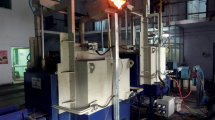Abstract
The increasing focus on sustainability of Steel Industries worldwide has brought in new trends, viz. maximizing utilization of assets and reduction of energy consumption and carbon footprint. Coke dry quenching (CDQ) technology for recovery of waste heat from hot coke to generate process steam and power is well established and adopted worldwide that meets these objectives of sustainable operation. Conceptualizing and executing CDQ technology in brown field site conditions throws up many challenges requiring innovative approach for technically and financially feasible solutions. The complexity of the situation is compounded with the requirement of proper technology selection based on space availability, synchronization of CDQ operation with oven pushing schedule, integration of the process with existing system, keeping the existing coke oven batteries operative as well as adhering to maintainability, process safety protocols and constructability of new facilities within the project execution schedule. Brief description of CDQ process, advantages and challenges for implementation of the same in brownfield unit has been described in this paper with examples/ references.












Similar content being viewed by others
References
Ministry of Environment memorandum F.No.22 34/2018-1A.III, dated Aug. 9, 2018
Iron making and General Industry Technology—Part 2 CCT Overview on CDQ at Japan on 11th January 2007, presented by Nippon Steel Engg. Co. Ltd. http://www.jcoal.or.jp/eng/cctinjapan/2_3A5.pdf
Dissemination Seminar for India Japan Model Project for CDQ organized by Ministry of Steel, Govt. of India, Tata Steel Limited at SNTI, Jamshedpur on 29th November 2011 presented by Nippon Steel Eng Co Ltd
Rout S.K., De M., Mandal A.K., Das B. (2019) Soil Nailing for Failed Slope Stabilization on Hilly Terrain. In: Sundaram R., Shahu J., Havanagi V. (eds) Geotechnics for Transportation Infrastructure. Lecture Notes in Civil Engineering, vol 28. Springer, Singapore. https://doi.org/https://doi.org/10.1007/978-981-13-6701-4_40
Acknowledgements
The authors are thankful to the Management of TCE for allowing to publish this paper with active participation of Tata Steel Limited (TSL). Joint project execution by TSL and TCE with successful commissioning of CDQ unit in a brown field CDQ project was a real team work.
Author information
Authors and Affiliations
Corresponding author
Additional information
Publisher's Note
Springer Nature remains neutral with regard to jurisdictional claims in published maps and institutional affiliations.
Disclaimer TCE with participation of TSL has prepared this paper based on research and analysis of material available in the public domain. The views expressed herein are considered opinions of subject matter experts. TCE does not make any representation explicitly or implicitly on the correctness of the contents in this paper and shall not be responsible for any use of, or reliance on the contents herein.
Rights and permissions
About this article
Cite this article
Bhatt, V., De, M., Chandra, B. et al. Design and Engineering Challenges for Installation of Coke Dry Quenching Plant in Brown Field Scenario. Trans Indian Inst Met 74, 1141–1153 (2021). https://doi.org/10.1007/s12666-020-02157-7
Received:
Accepted:
Published:
Issue Date:
DOI: https://doi.org/10.1007/s12666-020-02157-7




